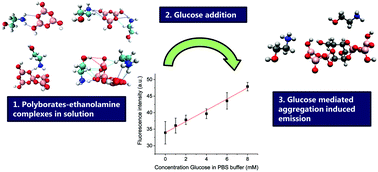当前位置:
X-MOL 学术
›
J. Mater. Chem. B
›
论文详情
Our official English website, www.x-mol.net, welcomes your
feedback! (Note: you will need to create a separate account there.)
Optical glucose sensing using ethanolamine–polyborate complexes†
Journal of Materials Chemistry B ( IF 6.1 ) Pub Date : 2018-01-11 00:00:00 , DOI: 10.1039/c7tb01790a C. Toncelli 1, 2, 3, 4, 5 , R. Innocenti Malini 1, 2, 3, 4, 5 , D. Jankowska 1, 2, 4, 5, 6 , F. Spano 1, 2, 3, 4, 5 , H. Cölfen 7, 8, 9, 10 , K. Maniura-Weber 1, 2, 4, 5, 6 , R. M. Rossi 1, 2, 3, 4, 5 , L. F. Boesel 1, 2, 3, 4, 5
Journal of Materials Chemistry B ( IF 6.1 ) Pub Date : 2018-01-11 00:00:00 , DOI: 10.1039/c7tb01790a C. Toncelli 1, 2, 3, 4, 5 , R. Innocenti Malini 1, 2, 3, 4, 5 , D. Jankowska 1, 2, 4, 5, 6 , F. Spano 1, 2, 3, 4, 5 , H. Cölfen 7, 8, 9, 10 , K. Maniura-Weber 1, 2, 4, 5, 6 , R. M. Rossi 1, 2, 3, 4, 5 , L. F. Boesel 1, 2, 3, 4, 5
Affiliation

|
Wound monitoring is essential to tackle chronic complications at their infancy and thus objectively scrutinize any delay in the epithelization process. Since glucose in wound exudates is recognized as key bio-marker in wound monitoring, the development of a cost-efficient detection method for glucose would aid at tackling early-stage infections in wounds. For the first time, we present a novel platform for one-step synthesis of non-enzymatic, cost-efficient optical glucose sensors. These are based on complexes formed by the interactions between polyborates and ethanolamines. The complexes, synthesized by just heating a solution of boric acid and ethanolamines at 150 °C, were characterized using 13C-NMR, 1H-NMR, 11B-NMR, analytical ultracentrifugation and DFT. The results show that the complexes in solution are extremely small (hydrodynamic diameter of around 0.5 nm) and that the polyborates species interact with the ethanolamines via both moderate and weak hydrogen bondings. These complexes were then tested on glucose concentrations ranging from 0 to 10 mM, showing significant changes in the fluorescent emission between the glucose level expressed in an healable wound (5.0–7.6 mM) and a chronic one (0.3–1.0 mM).
中文翻译:

使用乙醇胺-多硼酸盐配合物进行光学葡萄糖传感†
伤口监测对于在婴儿期处理慢性并发症至关重要,因此可以客观地检查上皮形成过程中的任何延迟。由于伤口渗出液中的葡萄糖被认为是伤口监测中的关键生物标志物,因此开发一种经济高效的葡萄糖检测方法将有助于应对伤口的早期感染。首次,我们提出了一种新型平台,用于非酶促,经济高效的光学葡萄糖传感器的一步合成。这些基于由多硼酸盐和乙醇胺之间的相互作用形成的络合物。通过在150°C下仅加热硼酸和乙醇胺的溶液合成的配合物,使用13 C-NMR,1 H-NMR,11进行表征。B-NMR,分析超速离心和DFT。结果表明,溶液中的络合物极小(流体动力学直径约为0.5 nm),并且多硼酸酯类物质通过中度和弱氢键与乙醇胺相互作用。然后对这些复合物的葡萄糖浓度范围从0到10 mM进行了测试,显示出在可治愈的伤口(5.0–7.6 mM)和慢性伤口(0.3–1.0 mM)中表达的葡萄糖水平之间的荧光发射有显着变化。
更新日期:2018-01-11
中文翻译:

使用乙醇胺-多硼酸盐配合物进行光学葡萄糖传感†
伤口监测对于在婴儿期处理慢性并发症至关重要,因此可以客观地检查上皮形成过程中的任何延迟。由于伤口渗出液中的葡萄糖被认为是伤口监测中的关键生物标志物,因此开发一种经济高效的葡萄糖检测方法将有助于应对伤口的早期感染。首次,我们提出了一种新型平台,用于非酶促,经济高效的光学葡萄糖传感器的一步合成。这些基于由多硼酸盐和乙醇胺之间的相互作用形成的络合物。通过在150°C下仅加热硼酸和乙醇胺的溶液合成的配合物,使用13 C-NMR,1 H-NMR,11进行表征。B-NMR,分析超速离心和DFT。结果表明,溶液中的络合物极小(流体动力学直径约为0.5 nm),并且多硼酸酯类物质通过中度和弱氢键与乙醇胺相互作用。然后对这些复合物的葡萄糖浓度范围从0到10 mM进行了测试,显示出在可治愈的伤口(5.0–7.6 mM)和慢性伤口(0.3–1.0 mM)中表达的葡萄糖水平之间的荧光发射有显着变化。











































 京公网安备 11010802027423号
京公网安备 11010802027423号